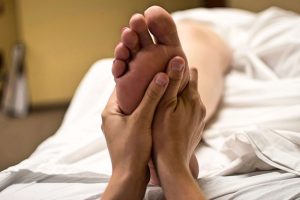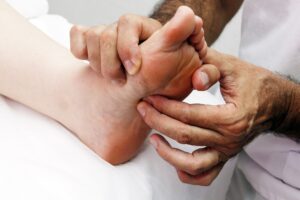What are the benefits of reflexology?
What is Reflexology?
Reflexology is a non-intrusive treatment based on the theory that there are areas and points on the feet, hands, ears and face that are connected through the nervous system onto corresponding parts of the body. If pressure is applied to these points, energy is stimulated and the movement of energy flows through the nerve channels restoring balance to the various parts of the body. This is a holistic treatment and can be used in conjunction with allopathic treatment to promote better healthcare for the patient.
Reflexology Training in Bath
We are delighted to be teaching a new Reflexology Professional Diploma Training at our Bath venue from Saturday 14th October. Check out more information here.

What are the benefits of Reflexology?
Although there isn’t scientific research to prove the benefits of reflexology, there are many considered benefits of reflexology.
These include:
- Relaxation and stress relief
- Enhanced circulation
- Assisting the body to normalise metabolism
- Boosting the immune system
- Helping with recovery from colds and other infections faster
- Clearing up sinus issues
- Help with back problems
- Hormonal rebalancing
- Boosting fertility
- Improving digestion
How does Reflexology work?
Reflexology stimulates the body into self-healing by improving circulation, reducing stress and pain and restoring the body’s natural balance. For example, if a therapist applies pressure to your big toe and ankle, this helps to calm your reproductive and endocrine system aiming to relieve PMS and side-effects of the menopause.
General Benefits of Reflexology
Relaxation
Reflexology is known to open neural pathways and flood the nervous system with neuron activity, putting the body in a more relaxed state. This can produce a state of calm throughout your body and mind. It can help to cure sleep disorders and help the body to return to its natural circadian rhythms.
Improvement of Nerve Functions
Ageing leads to nerve endings becoming less sensitive and in the body extremities. Opening and clearing out neural pathways can help improve the functionality and flexibility of nerves and cells in various organs of the body. It is beneficial to keep neural pathways clear and crucial to general health to keep them active. In this respect reflexology can be a useful tool.
Improvement in Brain Power
Information flows much faster and more effectively to the brain if the nerves and neural pathways are stimulated. Thus, the brain can process information faster giving faster cognitive and physical reactions and helps to boost the memory.
Increased Blood Circulation
The most well-known benefit of reflexology is improved blood circulation throughout the body meaning that oxygen gets delivered through the body more efficiently. This improved circulation means more oxygen reaches the vital organs improving their function and increasing metabolism. Faster oxygen delivered through the body results in faster healing and regrowth of damaged cells.
Elimination of Body’s Toxins
Increased blood circulation through reflexology improves the bladder function and helps reduce the chances of urinary tract infections. Thus, toxins and other foreign elements are more efficiently eliminated from the body. This protects the body from diseases and other health conditions that can be caused by a compromised urinary system.
Boosting Metabolism and Energy Levels
A good reflexology session can improve the function of many bodily organs resulting in a higher metabolic rate and more energy throughout your body.
Reducing Headaches
Stress and psychological factors often bring on physical symptoms especially through headaches and migraines. Reflexology can relieve stress and reduce the severity of migraines and general headaches by relieving tension in the muscles which cause headaches of any type.
Relieving discomfort from Menstruation and Pregnancy
Reflexology can be truly beneficial during pregnancy, especially with regard to labour lengths and the need for pain killers during labour as well as reducing the chances of post-natal depression. It can help the body to heal faster and get back to its normal metabolic activity sooner.
It may also alleviate many symptoms or painful menstruation.
Reflexology Courses
On our Bath Reflexology course, we teach our students about reflexology techniques and about the various systems of the body in great depth. We teach how each body system should function in a normal body, how they become out of sync and how you can help in promoting recovery through reflexology.
History of Reflexology
The student learns about every aspect of reflexology, its history, who can gain benefit from it, its aims and how it is used in practice today.
Reflexology zones
Although it can be used on the hands and ears as well as the feet, it is generally used on the feet. Because various parts of the feet mirror parts of the body, therefore, our students learn zones, guidelines and anatomy of the feet together with foot maps.
Reflexology training
Lessons include instruction on working with clients and what you need to be aware of. The various topics covered in preparation include taking a case history, knowing how to assess feet for ailments and understanding common problems with feet. Common techniques are taught in detail including the patients’ various sensations during and after treatment and the common side effects of the treatment.
Reflexology and the Digestive System
We teach the student about the digestive system, what foods are needed on a daily basis, the functions of the various digestive organs eg. pancreas, gall bladder, liver etc and about the process of peristalsis. The course also explains about the various problems that could arise if the digestive system goes wrong and how reflexology can do to help and then how to perform the necessary techniques on the appropriate parts of the feet.
Reflexology and the Respiratory System
Common disorders in the respiratory system are taught and how reflexology can aid these symptoms. It describes the process of blood circulation with particular attention being given to the heart area. The heart is described in detail and students are taught how reflexology can be used to strengthen the heart and treat heart related ailments.
Reflexology and the Lymphatic and Endocrine Systems
The entire lymphatic and endocrinal systems are described, including the lymph nodes, the thymus and the spleen. And the functions secreted from these glands. The course includes stress related hormones and how reflexology can be used to assist here.
Reflexology and the Nervous System
The purpose and function of the nervous system is taught including the sympathetic and parasympathetic divisions of the autonomic nervous system and the major parts of the brain. This section also covers the functions and structures of the ears, eyes and sinuses, what can go wrong in these areas and how reflexology aids recovery.
Reflexology and the Skeletal and Muscular Systems
We teach the musculo-skeletal system and include how reflexology helps with pain in various parts of this system. In this module students learn about the bones, muscles and joints of the hand. We also teach about how the hand is used instead of the feet to treat or aid symptoms and disorders in the body.
Setting up your Reflexology Business
At the end of the Reflexology course you gain ideas in setting up a reflexology practice. Areas for discussion include: research, setting working hours and what equipment you may need. And we also teach about administrative details. For instance, record keeping and book keeping, insurance and promotion of the business.
We highly recommend reading our Blog about setting up and establishing a Complementary Medicine Business.
Check out our many Google reviews at our Bath venue.
Check out our Youtube channel to find many free massage video resources. Subscribe to receive notifications of all new videos uploaded.


